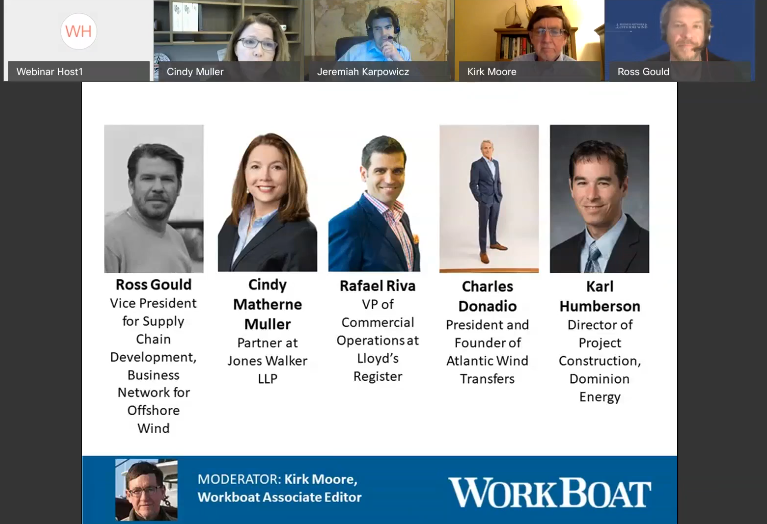Political winds of change are blowing, carbon counting is in, and renewables are hot. These and other factors have offshore wind sector professionals expecting clearer skies ahead for their sector, and have them planning for an imminent boom in business.
Industry experts say suppliers for the offshore wind sector have a few years of lead time before the boom is in full swing, according to panelists that took part in a recent WorkBoat webinar, “Operating on the (Wind) Farm.”
The need for purpose-built vessels and associated equipment used for offshore wind projects is expected to skyrocket in the next few years. Government funding for offshore wind development is expected to help build this new industry in the U.S. and overseas. But relying on suppliers in Europe for vessels and equipment for U.S. projects is unworkable due to logistics and costs, panelists said. It also may be unwise to rely on overseas suppliers, since such an end-run would appear to fly in the face of laws meant to help new industries develop in the U.S.
Some companies may think crossing the Atlantic with equipment for a wind project is feasible, but the Jones Act is meant to have such equipment built in the U.S., said Rafael Riva, vice-president of commercial operations for Lloyd’s Register. “We cannot continue thinking about European vessels — that is not going to work for the U.S.,” he said.
Others on the panel agreed. Karl Humberson, director of project construction for Dominion Energy, said a reliance on European companies for vessels is not ideal. Staging a project in Canada and bringing vessels to the U.S. is untenable. So, he said that this will create opportunities.
“You’re going to see exponential growth. Every port in the U.S. should be asking how they’re going to prepare for 2024, because that’s when the work will happen,” Humberson said.
Right now, U.S. offshore wind professionals are ramping up their professional networks, and learning from experiences of more-seasoned offshore wind pros who’ve worked in Europe and Asia. They’ve found that costs for building these sea-based wind farms is fostering industrial growth.
“There’s a reason Europe and Asia have moved to purpose-built vessels. (It’s) the cost of building these wind farms,” Humberson said. “The U.S. will need purpose-built vessels, specifically for this job of offshore wind.”
Dominion Energy currently is developing a vessel for the offshore wind sector. “That’s an investment in offshore wind, and how to do it,” Humberson said.
As a result of new government pollution standards and a greater focus on renewable energy sources, hope is growing in this new market. Other factors driving that optimism include the expectation that the offshore wind sector’s growth will lead to upgraded ports on the Atlantic and Pacific, manufacturing booms for shipbuilders, turbine manufacturers and others, plus the chance to be at the forefront of renewable energy technology. The upbeat mood is helpful, since offshore wind players need to be planning ahead for the near future, when the sector’s boom is expected.
“These ships don’t get built overnight. We know we all need a ton of them,” Riva said. “This is the way the industry will need to be looking. And the solutions are there, the engineering is there.”
While figuring the logistics of creating stable deepwater locations and ferrying workers and equipment to and from such sites is a large part of the planning process in preparing for the expected boom in business, creating purpose-built vessels for future wind power sites also is crucial. More than 100 vessels will need to be manufactured to assemble just one large offshore wind site, which bodes well for the U.S. shipbuilding sector.
“Some of my colleagues are calling 2021 ‘The Year of The Vessel,’” said Ross Gould, vice-president of supply chain development for the Business Network for Offshore Wind. There will be a significant need for vessels, and greater development of new models of vessels in the next few years, he added.
Because of the unique conditions experienced at offshore wind farms, vessels that service those sites will be the workhorses of the sector for years to come, and will be among the first technologies developed as this sector builds its capabilities in the next few years.
“What comes with the wind is sea conditions,” said Charles Donaido, president/founder of Atlantic Wind Transfers. “The crew transfer vessels are going to play a major part.”
Due to that hazardous environment, as well U.S. regulations regarding operation and safety of oceangoing vessels, future vessels built for the offshore wind sector are being created with safety in mind.
“We are moving increasingly to risk-based designs” for vessels, Riva said. “These vessels will need to comply with U.S. Coast Guard regulations.”
In addition to the need for upgraded ports, modern vessels, and new technology for operation of offshore wind farms, this new industry also will need many workers. Experienced workers — especially, perhaps, those who’ve worked in the oil and gas sector — will benefit from the need for employees able to quickly study and learn about offshore wind. Engineers of various kinds will be needed, of course, as will other workers.
“The oil and gas industry has a wealth of knowledge and people [that] can be applied to offshore wind and those vessels,” Humberson said. People working in the oil and gas industry should assess their skills and consider how they want to apply them, he added.
Oil and gas companies are experts in the extraction, production and transportation of gaseous and liquid fuels, a good foundation for an energy services worker. But the overlap in knowledge between oil and gas workers and the skills workers will need to work in offshore wind, while strong in any case, is even stronger when considering the possibilities of offshore wind farms that produce hydrogen for market.
Because of the existing oil and gas infrastructure in the Gulf of Mexico, there are some serious opportunities for hydrogen production there, Gould said.
Opportunities in this new sector will boost many businesses onshore, too. The recently announced $230 million in port grants from the U.S. government to strenghten and modernize ports is merely a kickstart.
“I foresee large staging areas for these ports … In the future you’ll have people coming together to figure out where the best places are to stage your equipment,” Humberson said.
Panelists in the webinar underscored the fact that, for the new offshore wind sector, things have really just begun.
“It’s just starting. It’s only the beginning for this offshore wind industry. This industry is going to take off,” Humberson said.
Riva agreed. “Things are really taking off very quickly. We all have to work together in the U.S. to make this effort happen, and to make it successful,” he said.
The webinar is available here, but you can also read through answers to questions that were submitted during the webinar provided by the panel in a “Your Questions Answered” Workboat.com follow up article.




